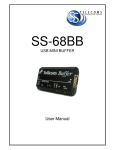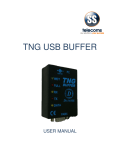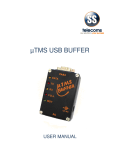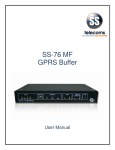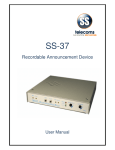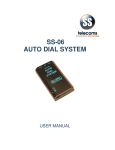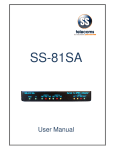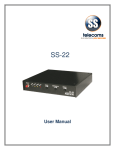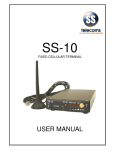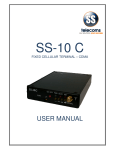Download SS-68BB MINI BUFFER
Transcript
SS-68BB MINI BUFFER User Manual SS-68bb MINI BUFFER USER MANUAL Revision History Revision 01 Revision 02 Revision 03 Original document Cosmetic Update Add Appendix A 2004 13 March 2008 10 December 2008 CONTENTS 1. INTRODUCTION ................................................................................................... 3 2. FEATURES ........................................................................................................... 3 3. 3.1 3.2 CONNECTIONS .................................................................................................... 3 PC Connection....................................................................................................... 3 PABX Connection .................................................................................................. 3 4. PROGRAMMING INSTRUCTIONS ....................................................................... 4 5. TECHNICAL SPECIFICATIONS ............................................................................ 5 6. CONTACT DETAILS.............................................................................................. 6 APPENDIX A: USING SS-68BB MINI BUFFER AS A SECURITY DONGLE ............... 7 Doc. No: SS-68bb MINI BUFFER (Rev.03) Page 2 of 8 SS-68bb MINI BUFFER USER MANUAL 1. INTRODUCTION The SS-68bb Mini Buffer is a call logging buffer that is supplied fitted standard with 128 Kbytes of RAM. Battery backup will allow logging in the event of power failure. 2. FEATURES Line powered. PABX connection OPTO-COUPLED Battery backed operation. PABX power used when PC is turned off Full functionality during battery operation. Beeper warning when buffer full. Compact. Easy installation. LED buffer status indications. UCT NOTES 3. CONNECTIONS 3.1 PC Connection PC Connection is by means of a female 9-way ‘D’ type connector. The cable to connect the Mini Buffer to a PC is a simple ‘1 to 1’ cable, with only pins 2, 3, 4, 5 and 7 being used. PIN # 3.2 PIN DESCRIPTION 2 Transmit to PC 3 Receive from PC 4 Handshake from PC 5 Ground 7 Power (to pin 7 on PC) PABX Connection PABX Connection is by means of a male 9-way ‘D’ type connector PIN # 2 4&7 5 6&8 PIN DESCRIPTION Data receive from PABX Handshake to PABX Common ‘Ground’ signal. Handshake from PABX Doc. No: SS-68bb MINI BUFFER (Rev.03) Page 3 of 8 SS-68bb MINI BUFFER USER MANUAL 4. PROGRAMMING INSTRUCTIONS Instruction Description S<enter> Requests a record in ASCII K<enter> Requests a compressed record N<enter> Advance record pointer. (Compressed mode only) DMP<enter> Dumps all stored data SC nn<enter> Sets Minimum Record Length. (Default = 0) 7 Bit operation if n = 1. Note: use for 7 bit only operation, do not S7 n<enter> use for 7 bit with parity Sets PABX baud rate, where nn represents the first two digits of SB nn<enter> the baud rate. Max 9600bps Sets PC baud rate, where nn represents the first two digits of the baud rate. Max 28800bps. Note: The new settings will be SP nn<enter> operational after the buffer is reset. SD n<enter> n = 1 enable Date/Time insertion, n = 0 disable Date/Time insertion. YY n<enter> Store Year if n = 1 YC n<enter> Store Century if n = 1 and n = 1 for YY T YYMMDDhhmm<enter> Sets the time SA n<enter> n = 1 Enable AutoDump; n = 0 Disable AutoDump SAT nn<enter> Sets AutoDump timer to nn*100 milliseconds CLR<enter> Clears the memory and reset SYS<enter> Displays system information HI<enter> Output Product Info, Maximum Memory Capacity, Used Memory and number of lines used DR n<enter> Text on reset: n = 0 Enable, n = 1 Disable SQ n<enter> Enables sequence number storing if n = 1 SH nn<enter> nn = 00 Keep Handshaking on until the buffer is full. (Rev 1.10 and above) nn = 01 to 63 Normal operation were the cycle time is 1 to 63 seconds with a 25% duty factor nn = AutoDump Auto Off Time in seconds When set this will stop response to SA n commands and it will SAO nn<enter> cause the AutoDump mode to be cleared when the handshaking has been off for more than the set time. AutoDump then has to be re-enabled using SA 1 V<enter> Displays Software Version number TM<enter> Does a memory test Doc. No: SS-68bb MINI BUFFER (Rev.03) Page 4 of 8 SS-68bb MINI BUFFER USER MANUAL 5. TECHNICAL SPECIFICATIONS Dimensions Housing LED indicators Connectors Black plastic 130 x 68 x 29 mm PC Tx & Rx, 80% & 50% buffer full, PABX DATA, Heart beat. Connection to PC: 9 way D-type female Connection to PABX: 9 way D-type male Storage medium Battery backed RAM buffering Storage capacity 128K - 4000 call records Setup storage Setup data is stored in non-volatile EEPROM Compatibility Compatible with most PABX’s units Required voltage 5V to 12V DC from PC handshaking lines Current consumption 5 mA to 10mA Battery backup PABX baud rate PC baud rate 3.6V 60mA Ni-Cad. Powers unit up to 2 days – Indefinite if PABX supplies power Software settable (Bd) 300, 600, 1200, 2400, 4800, 9600 Software settable (Bd) 300, 600, 1200, 2400, 4800, 9600,19200 Time stamping of call records and events Data compression, typical ratio 2.5:1 Data storage Warning beeper at 95% full DTR enabled dumping of records ASCII handshake protocol Fully error corrected proprietary protocol CONTACT DETAILS Doc. No: SS-68bb MINI BUFFER (Rev.03) Page 5 of 8 SS-68bb MINI BUFFER USER MANUAL Home >> >> 6. CONTACT DETAILS Office: 23 Botha Avenue Lyttelton Manor Pretoria, Gauteng South Africa Tel: +27 12 664 4644 Fax: +27 86 614 5625 E-mail: [email protected] Postal address: Postnet Suite 48 Private Bag x 1015 Lyttelton, 0140 Pretoria, Gauteng South Africa Sales Support: South Africa E-mail: [email protected] United Kingdom E-mail: [email protected] Technical Support: E-mail: [email protected] Doc. No: SS-68bb MINI BUFFER (Rev.03) Page 6 of 8 SS-68bb MINI BUFFER USER MANUAL APPENDIX A: USING SS-68BB MINI BUFFER AS A SECURITY DONGLE INTRODUCTION With the proliferation of software solutions it is becoming commonplace for software to be pirated or used without authorisation. A fairly standard solution is to provide a 'dongle' (hardware device) that attaches to the PC and the software will not run if the device is not present. This obvious lock is often a source of irritation to the end user. A more elegant solution is to provide a 'useful' device that acts as the security dongle. The data buffer is an obvious candidate for the task where a Telephone Management System is the application. SS Telecoms have developed a simple protocol that will allow software to verify that it is attached to a matching buffer. DISCUSSION ON SECURITY ISSUES There is a simple level of security provided by having a data buffer in the first place. Pitfalls can be identified such as Another hardware manufacturer can develop a buffer with a similar protocol. This means that it will be possible to hijack the software package by using these alternate buffers Another software vendor can adapt his software to work with the buffers and thus take over the installed base of buffers allowing this vendor a much cheaper entry to this customer than the original vendor Solution to issues The basic solution to the problems outlined above has already needed addressing in the GSM arena. Authentication of users is vital to ensure that billing is accurate, for example. How do they do this? It is done using a system known as 'Challenge / Response' authentication. This will be outlined briefly below. Challenge Response Description The PC software and the Buffer have both loaded with a secret key. This key can be up to 16 characters The PC sends the buffer a challenge consisting of a short randomly generated message of up to 10 characters. The Buffer performs a 'hashing' function on this message using the secret key as part of the process. It is not possible using a small number of messages to determine what the key is. The buffer then sends the result of the 'hashing' function to the PC. The PC then compares this to the result of internally generating the 'hash' result If the results match, then the buffer is authenticated and the software will run. IMPLEMENTATION Setting the key Use the command '~ nnkk<enter>' where '~' is the tilde character, followed by a space character and then the 2 digit hexadecimal offset ('nn') for the key character which is also sent hexadecimal ('kk') and <enter> is the Carriage Return character 0x0D. The sequence to set the secret code to 'TEST' is shown below: ~ 0054 ~ 0145 ~ 0253 ~ 0354 Doc. No: SS-68bb MINI BUFFER (Rev.03) Page 7 of 8 SS-68bb MINI BUFFER USER MANUAL The process has been automated and the code can be set and tested using the 'Buffer Lock' tool. Challenging the buffer The command to challenge the buffer is: 'CODErrr..rrr<enter>' where 'CODE' is the command, 'rrr..rrr' is the random challenge string up to 10 characters in length and <enter> is the Carriage Return character 0x0D. Buffer response The buffer will respond with the following: CODE: hhhh<enter> Where 'CODE: ' is the response text and 'hhhh' is a 16 bit CRC for the submitted challenge and the secret key. Response validation In the code below the variable CRC is a 16 bit unsigned integer and char is 8 bit. CmdBuf is the input buffer where the string starting with 'CODE: ' is stored and CmdPtr indexes the 1st 'h'. void CalcCrc(unsigned char { crc = (unsigned char)(crc crc ^= ser_data; crc ^= (unsigned char)(crc crc ^= (crc << 8) << 4; crc ^= ((crc & 0xff) << 4) crc &= 0xFFFF; } ser_data) >> 8) | (crc << 8); & 0xff) >> 4; << 1; void mfCode(void) { char * p = &CmdBuf[CmdPtr]; int retCrc = HexToInt(p,4); //convert the hex data to int crc = 0xFFFF; //initialise the crc //======== do the calculation on the challenge ============= for (unsigned int i = 0; i < strlen(test); i++) { CalcCrc(test[i]); } //======== do the calculation on the UserKey ============= for (int i = 0; i < strlen(SecretKey); i++) { CalcCrc(SecretKry[i]); } //==== crc should be equal to retCrc if all is well ========== } Doc. No: SS-68bb MINI BUFFER (Rev.03) Page 8 of 8








